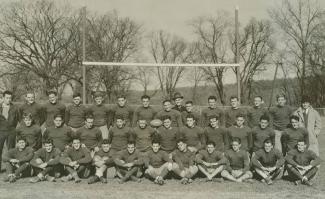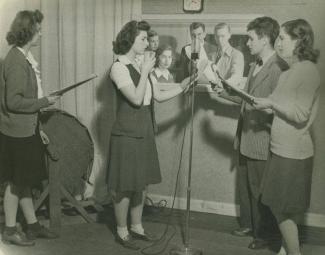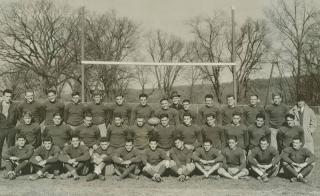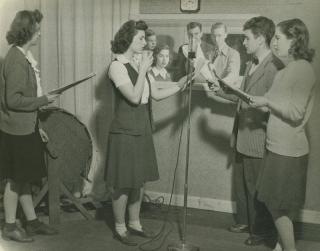Some of these independent institutes moved on, some died of larger cultural changes, and some were incorporated into Ithaca College when George Williams's tireless promotional efforts resulted in a 1931 college charter. But though we were now a college, our troubles were just beginning. With the Great Depression looming, Leonard Job, the new president, discovered some sizable bills outstanding with local banks and merchants—bills for mortgages, coal and groceries, laundry and plumbing services. And that, he realized, is how you spell bankrupt.
Years of Challenge
Through the Depression

The football team poses for a team photo in 1935. Coach Ben Light, for whom the current gymnasium in the Hill Center is named, stands on the right.
But Leonard Job, who assumed the presidency in 1932, was born on an Indiana farm and didn't know how to give up. So he called a meeting with the merchants and put his case simply: There's nothing you can collect—even the saltshakers are mortgaged. But if you forgive the College's debts, we'll all survive to do business together in the years ahead. The local merchants agreed to cancel old debts, and in 1937 the College was granted a new lease on life.
An Enrollment Roller Coaster
World War II hit College enrollment hard, sapping the population of male students and bringing the institution's weak finances to an even graver state. By September 1943 the College enrolled only 225 students, of whom 51 were male.
President Job contemplated closing the College "for the duration." But Ithaca College remained in session throughout the war years. By 1946, only three Septembers later, returning GIs swelled the numbers to 1,200, and the little downtown campus was suddenly bursting at the seams.
After the War
With the increased enrollment in the postwar years, renovated houses, old theaters, and the spaces above storefronts on State Street became classrooms and lecture halls. The demand for physical therapy gave impetus to our own fledgling program, now one of our established curricular strengths.
Now Leonard Job cast his eyes up South Hill and saw land—wide space for playing fields and physical education facilities. In 1949 he laid out the present South Hill playing fields, returning each day to supervise the bulldozers. By that time Freeman, Yavits, and Hill were already household names in Ithaca sports talk.
Frugal by nature, President Leonard Job refused to pay the $15,000 in surveyor's and engineer's fees on the Dworsky-Campbell homestead. Instead he purchased a used surveyor's transit for $100 and gave himself a crash course in surveying. Ithacans coming and going on Danby Road would see President Job, morning and afternoon, out on South Hill laying out the athletic fields.

Students rehearse a radio broadcast, circa 1948.
Meanwhile, Ithaca was producing musicians, music teachers, physical education teachers, physical therapists, and actors. In 1948 an army-surplus Quonset was set down at Court and Cayuga Streets and fitted out with a slightly-less-than-mighty 10-watt transmitter. Ithaca College radio was on the air. By 1958 the new television and radio facilities on Buffalo Street were in operation. Ithaca College television offered everything from game and talk shows to college classes and tax advice—on cable. The whole town was watching.


